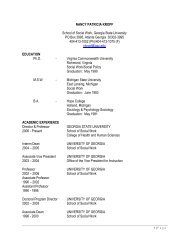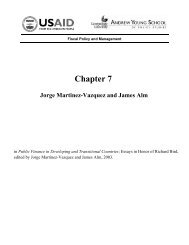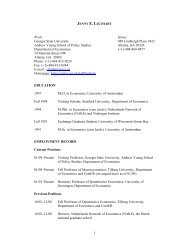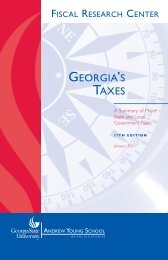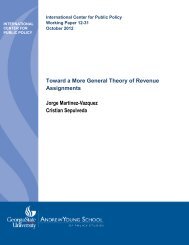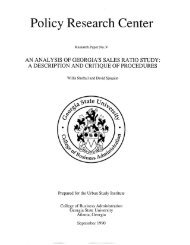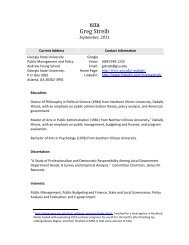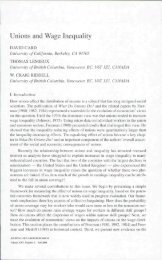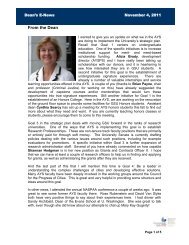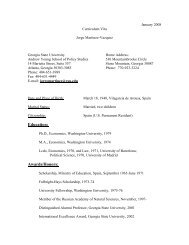Robin Boadway and Frank Flatters - Andrew Young School of Policy ...
Robin Boadway and Frank Flatters - Andrew Young School of Policy ...
Robin Boadway and Frank Flatters - Andrew Young School of Policy ...
You also want an ePaper? Increase the reach of your titles
YUMPU automatically turns print PDFs into web optimized ePapers that Google loves.
624 / <strong>Robin</strong> <strong>Boadway</strong> <strong>and</strong> <strong>Frank</strong> <strong>Flatters</strong><br />
labour income at the rate ti, on property income at the rate mi, on locally generated<br />
rents at the rate xi, <strong>and</strong> on local capital returns at the rate zi. Thus, ti <strong>and</strong> mi may be<br />
thought <strong>of</strong> as residence-based taxes while xi <strong>and</strong> zi are source-based taxes.<br />
Individuals obtain utility from the private good <strong>and</strong> the provincial public good.<br />
The per capita consumption <strong>of</strong> the private good in province i is determined by<br />
after-tax income:<br />
Xi = fi(1<br />
-<br />
ti) + 1(1 - mi)[Rl(1 - xl) + R2(1 - x2) + fK'(1 - zl)K<br />
+ fK2(1 -2)(K - K1)], (13)<br />
where Ri is the rent generated in province i <strong>and</strong>, by assumption, is given by:<br />
Ri(Li, Ki) = f (Li, Ki) - LifLi(Li, Ki) - KifK(Li, Ki). (14)<br />
Note that dRidJLi = -<br />
LifLLi<br />
-<br />
KifKL1 <strong>and</strong> dRid/Ki = - -<br />
KifKK LifKLi. These are<br />
<strong>of</strong> ambiguous sign. We have also assumed that the total stock <strong>of</strong> capital in the nation is<br />
fixed at K <strong>and</strong> the return to capital is determined endogenously. An alternative<br />
approach would have been to allow foreign capital to come in at a given world rate <strong>of</strong><br />
return. The analysis is similar in this case.<br />
Provincial government expenditures are financed entirely by taxes in this 'real'<br />
economy. The government budget constraint is given by:<br />
Gi = tifLLi + mi[P]Li,L + xiRi + zifKiKi, (15)<br />
where the P denotes total property income across provinces <strong>and</strong> is given by the term in<br />
square brackets in (13). Substituting (15) into (13) we obtain the expression for<br />
private goods expenditures with the government budget implicitly accounted for:<br />
Xi = fL + PP + xiRilLi + zif'Ki/Li<br />
- Gi/Li. (16)<br />
Notice that ti <strong>and</strong> mi have disappeared from this formulation. The reason is as<br />
follows. First, ti <strong>and</strong> mi are essentially perfect substitutes in this model. Both are<br />
taxes levied on the basis <strong>of</strong> residency <strong>and</strong>, other than influences on the migration<br />
decision, there are no disincentive effects associated with them (e.g., labour supply is<br />
fixed). Next, from the point <strong>of</strong> view <strong>of</strong> (15) <strong>and</strong> (16), these residency-based taxes are<br />
essentially budget-balancing items that disappeared when (15) was substituted into<br />
(13). In the following analysis, the amount <strong>of</strong> residency-based tax collected is that<br />
residually required to balance the budget. Whether ti, mi or some combination is used<br />
is irrelevant. One could also interpret the general retail sales tax as equivalent to a<br />
uniform income tax in this model.<br />
Equilibrium in a two-province economy will be characterized by the simultaneous<br />
satisfaction <strong>of</strong> a migration equilibrium condition <strong>and</strong> a capital market equilibrium<br />
condition. Under free migration the former is given by:<br />
ul[L1 + P1P + xlR1/L1 + zlfKK/LI<br />
- G1/L1, G1] =<br />
U2V2 + -3P<br />
+ x2R2/(N - L1) + -<br />
z2fK2(K K)/(N<br />
-<br />
L)<br />
- G2(N - L1), G2]. (17)<br />
where L1 <strong>and</strong> K1 are the labour <strong>and</strong> capital supplies in province 1, <strong>and</strong> the residuals



